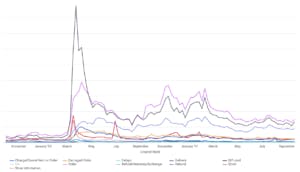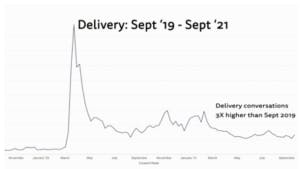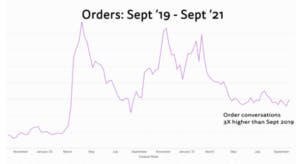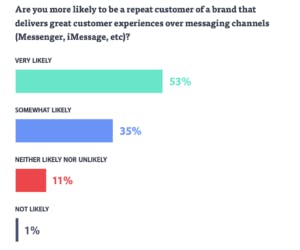How to Keep Customers Loyal and Happy in the Face of Global Supply Chain Challenges


After 18 months of adjustments and adaptation in the retail and eCommerce industries, businesses might have hoped that the world slowly reopening, with 6.6 billion Covid vaccines already administered, would ease some of the pressure they’ve been facing. But no such luck, because there’s a global supply chain crisis which makes the Ever Given blocking the Suez Canal seem like ‘the good old days’.
The issues affecting the supply chain aren’t all directly Covid related, but many are a knock-on effect from the pandemic.
In the UK there’s been a perfect storm of fallout from Covid and Brexit which are combining to hit industries across the spectrum. It’s led to a lack of qualified truck drivers, at least 100,000 to be exact, which saw a couple of weeks of empty petrol stations and panic buying (which always leads to panic buying by non-panic buyers in order to avoid the consequences of panic buying etc etc etc).
“What we’re facing is a crisis from restrictions, not the virus itself. Demand is very high but supply is very disrupted. Without questions there is a risk of disruption as demand rises.”
Willie Walsh, Int’l Air Transport Association
It’s also affecting supply chains for supermarkets, and while it’s not a full-blown crisis (yet), there are empty shelves appearing across the country for certain items – a situation causing headaches for the government in the run up to the holiday season. Not surprising if you’ve got a 100,000 person sized hole in the supply process.
The UK isn’t an isolated case, the US is having similar worries in the lead up to December. Container ships are sitting in the Pacific, as a bottleneck builds at two of the country’s busiest ports. Border restrictions, distancing requirements and factory closures, alongside a shortage of transport workers is squeezing traditional supply chains. Freight shipping costs are rising and ports are congested so deliveries are delayed and it’s not expected to get better any time soon.
You may wonder what this has got to do with digital customer engagement. Well, if there’s one thing we know about customers, it’s that if their products start to cost more, take forever to arrive or aren’t even in stock, they will have legitimate cause to get in touch and let brands know they’re not happy about it.
Supply chains are expensive to fix and it’s not an overnight process, so understanding where and when you’re going to be dealing with customer queries and complaints is vital. To do it effectively, you first have to map consumer trends and how they’ve changed since Covid hit.
Conversational Intent Data: How Customer Habits Have Shifted
The graph below shows all conversations with Conversocial, A Verint Company, retail partners over a two year period. Analyzing the trends tells us three main things:
- The March 2020 spike, especially in delivery intents (black line), was unprecedented.
- The UK Lockdown’s Digital Christmas in 2020 saw customer conversations about orders and deliveries at the same level as when the pandemic first hit.
- Conversational volume around the three biggest intents (orders, deliveries and refunds) is now 3x higher than 2 years ago – way before Covid-19 was a global event.

And we can dig a little deeper into that final point as we look at changing customer habits.
Intent: Deliveries
This was the conversational intent that was most prevalent at the start of the pandemic, with by far the biggest spike in March 2020. It was so big, that it actually distorts the rest of the data to the point that it’s difficult to see the full story.

The volume levelled off around June 2020, before another big surge around the holidays, when much of the UK and US (where most of our retail partners are based) were still locked down and had no choice but to have a ’digital Christmas’. But as of September this year, with Covid having lower impact on customers habits, the volume is still 3x that of the same period in 2019.
It’s easier to illustrate this with a different conversational intent.
Intent: Orders
This follows a similar pattern to delivery, but the two spikes in 2020 were of similar magnitude, so we can get a better perspective on the change in consumer habits over the past two years.

There were understandable surges twice in 2020, but it’s the last six months, after the trends have levelled out which give us the most telling data. Being locked down at Christmas would mean customers getting in touch about orders through messaging channels was always going to happen, but since May this year, it’s hard to ignore that conversations are still way above pre-pandemic levels.
Using Digital Channels to Engage Customers During Supply Chain Issues
One of the main themes we’ve been discussing at Conversocial, A Verint Company, for the whole of this year is the digital reckoning brought about by Covid. Consumers have recognized that messaging channels are more convenient and even though they don’t have to use them to communicate with their favourite brands, they’re now a preference.
To bring this full circle to the supply chain issues – when facing customer queries or complaints, being able to address them on a preferred channel and providing an experience that is satisfactory and straightforward will be hugely important for customer retention.
Often the customer who reaches out and has a good experience will become a more loyal repeat customer. In our State of CX Trends Report 2021, we actually found that 88% of consumers surveyed would stick with a brand that delivers great CX over messaging channels.

There’s clearly a move towards messaging channels as the preferred option for brand/consumer interaction. If we anticipate the types of issues and volume of customer conversations retailers are going to be experiencing in the run up to their busiest period of the year, brands who don’t already recognize both the popularity and power of messaging channels don’t have much time to change things to offset the potential fallout.
The scope of messaging channels for providing continuous conversations across a customer’s lifecycle is what makes them the most powerful tool in a brand’s arsenal. From regular, proactive updates telling customers each stage of a delivery process to conversations that deal with queries around delays or stock shortages, brands can keep people informed and up to date on the latest developments.
By analysing the most common customer intents, currently and for previous holiday periods, and where potential problems could arise due to the global supply chain issues, brands can use intelligent automation to counteract the inevitable surge in customer conversations. It leaves human agents free to handle more complex queries and complaints. If bots are doing the heavy lifting, the empathy required from human interactions can be even more effective if your agents aren’t overrun with customer conversations.
These supply chain issues won’t be a quick fix, and every sign points to more problems between now and the start of 2022. But it creates an opportunity to solidify relationships with your customers, so they’ll still be there when things start to feel less strained, and potentially more loyal than before. Regular and personalized communications will mean more when consumers are worried their presents might not arrive in time, than when the shelves are fully stocked and the world has a full complement of delivery drivers.